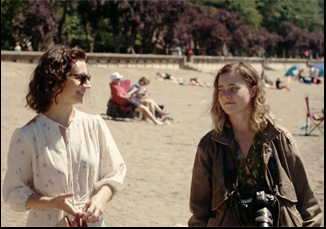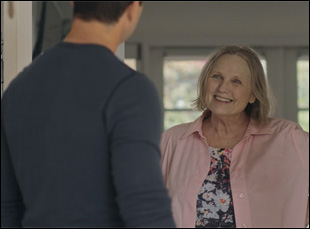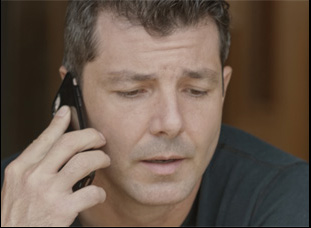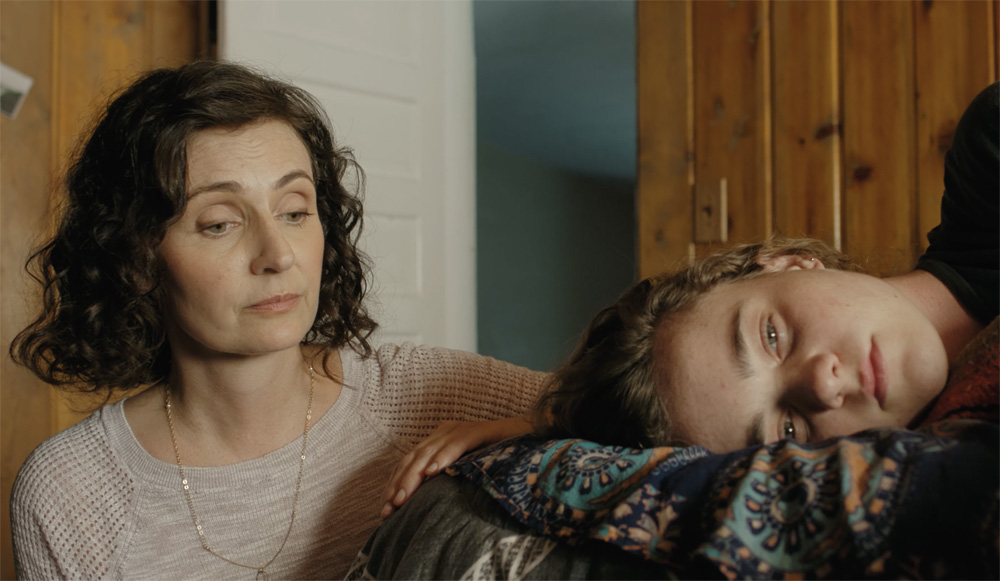In one of her group meetings in “The Good Side of Bad,” Florence (Lexi Simonsen) refers back to her background in photography to explain the place she’d like to be, “the stillpoint” where the world around the subject has settled to take a picture without the threat of blurring and there is no burden of the past or future on the moment at hand. It’s where everybody in Alethea Root and Jules Bruff’s second collaboration would like to be, though Florence’s worsening condition won’t allow it for her siblings Sarah (Bruff) and Peter (Alex Quijano), who not only have to contend with their younger sister having schizophrenia, but also their mother Mary Ellen (Tess Harper), who has been living for some time with dementia. A flashpoint occurs when Florence comes perilously close to ending her own life, nearly running right off a bridge that she insists wasn’t a suicide attempt but an escape from people chasing her, and though there is no evidence there was anyone to flee from, the family all finds themselves chasing ghosts when Sarah and Peter try to reconcile the people they remember with those who are slowly being taking from them by disease.
One can see how Root and Bruff were uniquely suited to adapt Beverly Olevin’s Pacific Northwest-set novel from which the film takes its title, having previously tackle the often elusive subject of mental health in “Part-Time Fabulous,” in which Bruff starred as a woman whose whirlwind romance takes a turn when symptoms of her clinical depression start to rear their ugly head, and in “The Good Side of Bad,” they once again take a conscientious approach to such sensitive subject matter, watching as Sarah and Peter attempt to respect the autonomy of other family members while deciding when its best to take control when it’s in their best interests. Alternating perspectives between the two of them and Florence and Mary Ellen, who deal with the isolation of being inside their own minds in very different ways, the film shows how difficult it is for the family to exist as such even when everyone wants the same thing but are all operating from very different ideas about what it is right and circumstances dictate that they shouldn’t even be in the same room together.
While the situation itself is stifling, “The Good Side of Bad” proves refreshing in being able to see everyone’s point of view and it proves to be an ideal opening night selection for the Dances with Films Festival, starting this evening in Los Angeles where a host of independent-minded films both in spirit and production are set to make their bows. Graciously, Root and Bruff took some time away from the week of their big premiere to talk about bringing this story to the screen against all odds, not only having to navigate such tricky tonal territory but setting up a shoot just as the world was starting to emerge from the pandemic and how the film could reflect the strength of families both in front of and behind the camera.

Jules Bruff: Yeah, it wasn’t intentional at the beginning, but I feel like I’m an accidental mental health advocate, and for our first one, I was arguing with my boyfriend at the time and he’s like, “You’re a part time fabulous.” And I [realized in the moment], “Oh, that’s the name of a movie.” And I said, “Hey man, can I use that as the name of a movie?” And in that moment, Alethea and her husband popped into my head and I [thought], “I should ask her to direct it.” And when Alethea and I started having the conversation, she’s like, “Well, what does that mean?” And my idea [of that film] for me was a couple [where] at home, they have one thing going on, but in public, they’re fabulous, but [when Alethea asked about the title] I was like, “Well, I don’t talk about this much, but I was diagnosed with clinical depression when I was like 20, and I’m very high functioning…” And she was like, “We should tell that story, not about couples being perfect in public versus at home.” And I didn’t want to because it’s very personal, but she’s very persuasive.
Alethea Root: I actually grew up in an intentional community called Camp Hill and Life Sharing and we took care of people with Down syndrome or autism [who] lived in our home like family. My parents were called the house parents and we were the house children and we just lived in community and with many other communities and households, so mental health and being understanding and loving and being inclusive has always been a part of who I am, so when Jules was sharing her very personal story, I was like, “How do we see ourselves in the other and take care of each other? How do we not have this diagnosis of schizophrenia or clinical depression or whatever the diagnosis is and not let that define who we are, but how do we let it improve where we are and help the community at large?” So it was nice that just by happenstance, Jules brought this to me.
Jules Bruff: Yeah, and then I was reading this award-winning indie novel called “The Good Side of Bad” by Beverly Olevin about schizophrenia and I hadn’t anticipated or intended to do a second mental health-themed project, but I thought it was so stunning and I have some I there’s schizophrenia in my family. So I said [to Alethea], “I’ll think you got to read this book…”
Alethea Root: And I fell in love with it and with how you have to step into each character to understand them and then see each character through the other character, so you get to have your own relationship with them. And as a filmmaker and an artist, it’s about seeing ourselves in the other and having true empathy, so when I read the book, I was like, “This is who I am. This is what I want to do in the world.”

Jules Bruff: Adapting the book into a screenplay with Cierra Danielle and Aletheia was super challenging, but each chapter of “The Good Side of Bad” focuses on one of the siblings. We ended up really honing in more on the youngest sibling, Florence, making her the protagonist because she’s the one with the diagnosis.
Alethea Root: One of the challenges we gave ourselves was that we weren’t going to do voiceover and we were going to show it, don’t tell it, so for each character, the original thought was, “We’ll have a voiceover like ‘Mudbound’ where we’ll tell each story,” but we realized the story could have focused on anyone. We could have focused on Sarah or Peter, but really the heart is with Florence and because her diagnosis is the inciting incident, everything happens around her, so our mantra [became] how does everyone come around her and help her? And in so helping each other, how do we help ourselves and also improve as humans? Those were the themes that we carried over from the book.

Jules Bruff: Of course I did! [laughs] I call myself a triple threat — I don’t sing or dance, but I act, produce and write, so it’s the new take on a triple threat. And when I read [“The Good Side of Bad”], I wanted to play [Florence] because that’s the meaty role, right? But then doing a deep dive into the research on schizophrenia, it’s generally earlier [in a person’s life like] late teens, early twenties, maybe late 20s, and occasionally, there is an adult in your forties, but in terms of trying to be as authentic as possible, we thought that it would be best for the diagnosis to be with the youngest sibling. And we couldn’t afford a casting director, but I’ve been a working actor for over 20 years, so I have the great honor to know a ton of super-talented people. I brought in all of my friends and [had] referrals from other people and Lexi Simonsen and Alex Quijano came in and their auditions blew us out of the water.
Alethea Root: It was just about making sure their chemistry was great, and in the indie world, you really do rely on your friends and the people who you’re working with to bring wonderful cast in. When we were looking at people for the character of Dennis, a love interest for Florence, the producers were giving us advice and one of our cast members Storie [Blake], who was also our prop master, said, “Hey, I know this great guy, Myles Grier.” And I fell in love with him right away, so it’s like a film is like a billion little pieces that come together to make the picture and without the support of everyone in the cast and the crew coming together, it doesn’t happen and everybody gets to have a little piece.

Jules Bruff: Yeah, it was a little crazy. We shot it in August 2020, so we were one of the first productions to implement all of SAG’s COVID regulations, which were really intense and nobody got sick. But [it was a] wild, wacky experience of having to send someone to the ER because they’re worried that they have a scratchy throat to having COVID compliance officers and Althea is trying to direct with a mask on her face. It’s a special movie that I will, until the day I die, be so grateful for. We were a little bananas [to think], “Let’s just make this happen during the pandemic.” But everybody was bored, nobody had work, and some renegades like us were like, “Yeah, let’s do it.”
Alethea Root: Yeah, in hindsight, it’s like, “We’re filmmakers. That’s what we’re going to be doing during the pandemic. We’re not going to stop. No one’s going to tell us no.” And we were compliant and it did keep everyone safe. No one was allowed to go out and party — we had everyone sign a commitment letter, so then that commitment letter really followed through to the production and it was pretty exciting.
What was it like filming in Spokane?
Alethea Root: It was awesome because it was so beautiful and my friend Carol lives [there] and has for years and years and years, so in the morning, she would drive me around town and I’d be like, “Oh, I need this location.” And I’d pin it, I’d send it to the line producer Jenny, and she would then put it into the schedule and then the next day or week, we would just go shoot there.
Jules Bruff: Yeah, they don’t require permits in Spokane.
Alethea Root: We didn’t have to go through any red tape and everywhere you look is beautiful and everywhere you look you can film. We had a street scene and we went to this cute little town and I was like, “Let’s shoot here” and then two days later we were shooting there and no one interrupted us. The architecture was beautiful, and the home which Jules found, we rented on AirBnB and it was gorgeous. When we were conceptualizing the [home in] the script, I really wanted this idea of framing [where we’d] be able to see from the living room to the dining room to the kitchen and I originally conceived like a sunken living room with a dining room here and then the kitchen over here. We didn’t get that, but we definitely got this framing and this house had so many beautiful frames. We had a door within a door within an archway and the DP and I really had a lot of fun with that. I would shoot in Spokane again in a heartbeat.

Alethea Root: Yeah, because of COVID, we had to really rethink our script and our locations and we were able to do it all there, and one of our producers, Katie Von Till, her family is from Coeur d’Alene, so she’s like, “Hey, you can stay in my parents’ place — and, oh, my sister-in-law has a restaurant and you can shoot there.”
Jules Bruff: And then one of her nieces Freya Von Till was one of our location scouts, and another one of her nieces Emma Von Till acted in it and was also the director’s assistant and costume assistant, and then Katie’s parents helped, so it was a super family affair. Our whole theme was family coming around to help the schizophrenia and in the real world, all the family came around to help us make this movie.
The final product has that quality about it. What’s it like to get to the place of premiering it?
Jules Bruff: It’s such a treat. Originally were trying to do super big budget version of it, and then pandemic hit and I was being dramatic, [thinking] “What if I’m going to die from this plague? What would I want to be doing?” And I was like, “I want to make another movie,” so to have positive feedback and feel like we did it — the fact that [Dances with Films], this true indie spirit festival, chose us to be opening night film is just such an honor. It’s unbelievable.
Alethea Root: Yeah, it’s a lot of work obviously to get to a premiere, but now Jules and I have been texting back and forth about our dresses and those little joys, like, “I’m going to take a minute and try on this dress” — [amidst] the crunch to make sure everything is picture perfect, sound perfect. Everything is on theme and consistent and it’s going to be fun to celebrate and just enjoy [the premiere] on Thursday night.
“Good Side of Bad” will screen at Dances with Films in Los Angeles at the TCL Chinese 6 on June 22nd at 7:30 pm.




